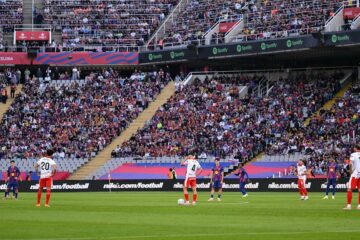After winning the Premier League fairly comfortably last season, Liverpool reinforced their squad with some of Europe’s most impressive talent.
Arne Slot’s Reds spent about £416.2m on summer signings, the most spent by any club in a window, bringing the likes of Alexander Isak, Florian Wirtz and Hugo Ekitike to Anfield.
But, despite sitting third in the table, Liverpool have lost three matches in a row in all competitions and host Manchester United on Sunday with a few questions being asked about them.
New signings need time to gel but the departure of Trent Alexander-Arnold to Real Madrid may have had a larger impact on Liverpool’s squad as a whole than first thought.
Despite being questioned for his defensive ability at times, the 27-year-old scored 18 goals and contributed 64 assists in his time at the club – but his absence is being felt for less obvious reasons.
Here we analyse what Liverpool are missing this season in Alexander-Arnold’s absence.
Reds struggling against high defensive block
The Premier League is home to some of the best executed defensive set-ups in the world whether that is in the form of physical high-presses or stubborn and compact blocks.
Bypassing a high press can be done in two ways: by playing through the pressure or by going long and playing over the pressure.
Against a good press or a higher defensive block, Liverpool have struggled to get the ball up the pitch as effectively as they did last season.
This can partly be explained by Alexander-Arnold’s on-ball quality and using an example against Spurs last season helps illustrate the point. Throughout the game, Spurs applied a high press looking to win the ball early. The right-back’s body was angled in field and, with Son Heung-min closing Alexander-Arnold down quickly, access to players in the wide areas was cut off.
A massively underrated part of Trent’s game, and one that Liverpool miss greatly, is his ability to play with his weak foot. In this scenario, Trent was able to use his left foot to accurately sweep a pass into the unmarked Alexis Mac Allister.
A hallmark of Liverpool’s build-up last season was in finding the midfielders centrally who were often staggered.
In this example, Ryan Gravenberch has left the centre of the pitch to move into the right flank dragging his marker with him. Mac Allister comes over and Dominik Szoboszlai arrives to form a sort of zig-zag-like shape.
This staggered positioning allowed Liverpool to bounce passes around late-arriving pressure between the midfielders and full-backs with minimal touches used getting up the pitch.
Bradley less accomplished with weaker foot
In the defeat by Chelsea, Slot opted for Conor Bradley at right-back, who found himself in a very similar situation as Alexander-Arnold did against Spurs; Alejandro Garnacho pressed high, Bradley was facing in-field, and access to the wide areas was cut off.
Bradley, similar to his right-back rival Jeremie Frimpong, is less accomplished on his weak foot and as a result was unable to build up play centrally in these scenarios.
With a pass on into the midfield, Bradley instead played with his right foot back to Ibrahima Konate. This restarted the build-up with the same problems needing to be tackled from the beginning.





